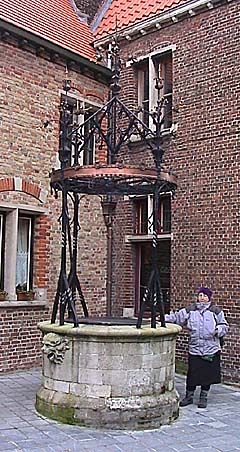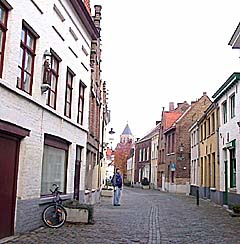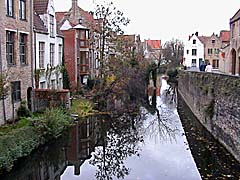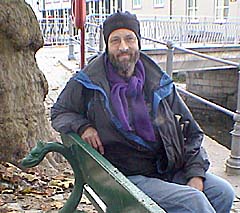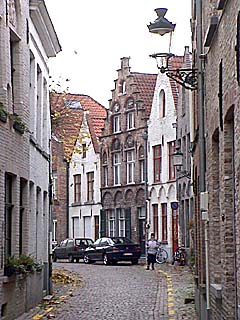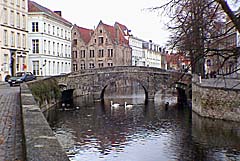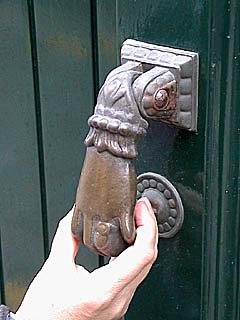
Week 9, part 2
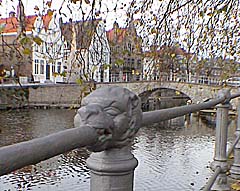 Some creativity adorns a railing along a Bruges canal.
Could this be Bruges' first well?
Obbie walks the streets of Bruges.
A row of houses reflects off the surface of one of Bruges' minor canals.
|
It was pushing 8 o'clock when we arrived in Bruges, but the tourist information office at the station was still open. The lady behind the counter suggested the hostel, which should have been a ten minute walk into town. We could have bought a map for 20 francs (about 50 cents), but we hadn't gotten any Belgian money yet, and this station didn't have a cash machine. We set out into town with the directions to our hotel drawn on a piece of paper. It didn't take long to make a wrong turn and get lost in the medieval maze that is Bruges. By the time we found our hostel, called Passage, we'd schlepped our packs around town for about an hour, asked for directions four or five times, and had our sense of direction turned backwards. Along the way we found a machine that dispensed a couple of days worth of Belgian money, even though we had to try three or four machines. For 1000 francs (about $25) we got a double room on the ground floor with almost enough heat and a bed with springs that poked into our butts as we slept. Since the "off season" was well under way, the hostel was in the midst of being repainted and refurbished; so we were awakened by a vacuum cleaner nozzle dancing about on the floor above us. The painter appologized profusely, and over the next couple of days we had some nice chats with him as we went in and out. Over breakfast, we arranged to move to a room down the hall that had a private bathroom, a nicer mattress, reliable heat, and a nice space to sit and lounge. Our room rate went up to 1200 francs/night ($30), and we found ourselves in a room we'd be happy with for our last two days and nights on the continent. Tuesday and Wednesday were days to walk around and explore this relatively small town. Bruges was founded and built when years had three-digit numbers, and it prospered as a port serving the cloth trade. In the 15th century the entrance to the city's network of canals had silted up and Bruges became a ghost town for a few hundred years. One account said that Bruges "became so poor that no one bothered to tear it down." Bruges was discovered by tourists in the 19th century, and it is now one of the most well-preserved medieval towns in Europe. Over breakfast, our hosts gave us directions to a nearby office where we could buy a local street map. Armed with these directions transcribed onto a napkin, we found our way without incident. Once we had our map we could explore the nooks and crannies of this town without getting lost. We wanted to avoid the main drags as much as possible, as they were overrun by mutant shopper zombies. Good maps are the best value for the money that a traveller can ask for. Most European cities are not laid out in neat grids as American cities are, and most European streets are narrow and they twist and meander between high walls of tightly-packed buildings. Without a map, it's easy to feel like a lab rat. With a map you can not only find your way, but if you do get lost and you have to ask for directions from someone who doesn't speak English, a map is a point of reference that transcends languages.
|
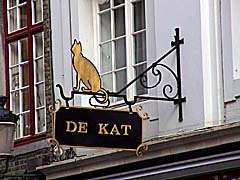 An elegant sign for a shop in Bruges.
Obbie takes a break in Bruges.
RoZ walks the streets of Bruges.
Swans hang out under a bridge on a Bruges canal.
A door handle somewhere in Bruges.
|
Next page
week 9 index
purplearth 2001 europe oddyzee index
purplearth home
